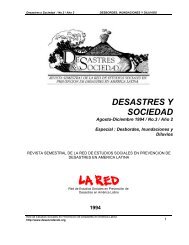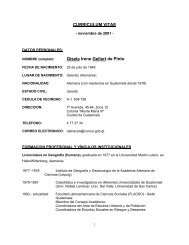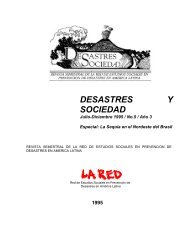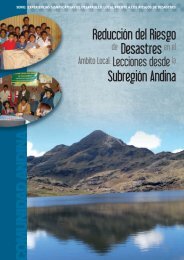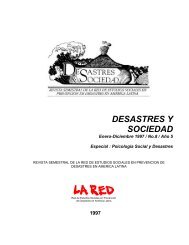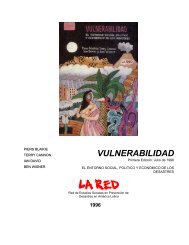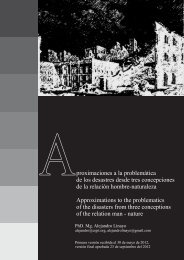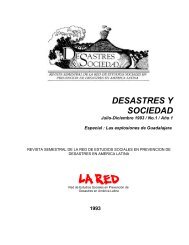Estrategias sociales de prevención y adaptación Social ... - La RED
Estrategias sociales de prevención y adaptación Social ... - La RED
Estrategias sociales de prevención y adaptación Social ... - La RED
You also want an ePaper? Increase the reach of your titles
YUMPU automatically turns print PDFs into web optimized ePapers that Google loves.
Historical and anthropological research reveals that people are quite aware of the risk<br />
they live with unless that risk only very rarely translates into a disaster. A flood is forgotten<br />
after only a few years and when no fresh flood occurs, a fatalistic mindset sets in, other worries<br />
take over and people care less about what happens to their river (Hartmann, 2010).<br />
This can lead to <strong>de</strong>featism – whatever may flood, floods. This indifference is civil why engineers,<br />
who tend to be hierarchical in mindset in their own folklore immortalised in the<br />
Dutch Royal Institute for Civil Engineering, pray to God for the return of a flood: “Lord,<br />
give us our daily bread, and a <strong>de</strong>cent flood every <strong>de</strong>ca<strong>de</strong>.”<br />
Their own success however has prevented the engineer’s prayer being answered. In<strong>de</strong>ed<br />
in the Netherlands, the national grid of sea and river dikes have been so successful in keeping<br />
out river and sea peaks that people have lost their awareness of the residual risk. Flood<br />
risk is rarely communicated to citizens, second-home owners and tourists. As a consequence,<br />
the false sense of security is reinforced. A “control paradox” (Immink, 2008) has encouraged<br />
building behind the dikes, so that wealth and people amassed. Local governments<br />
have been very slack in controlling settlement in the river floodplain.<br />
A period of protest and slack action started in the 1980s. The already apparent limitations<br />
to building and heightening dikes and of pol<strong>de</strong>ring, notably subsi<strong>de</strong>nce (Noordoostpol<strong>de</strong>r)<br />
became visible.<br />
In the mid 90s, the cultural cycle however came full circle. In late 1993 and early 1995<br />
Nature´s cru<strong>de</strong> wake-up call remin<strong>de</strong>d the Dutch of living in a state of “residual risk”. In<br />
1995 over 200,000 people were preventively evacuated as dikes were close to bursting on the<br />
Dutch rivers Rhine, Maas and Ijssel.<br />
The two high-water events, though minor, shocked the Dutch out of a prevailing mood<br />
of complacency. “Never again” became a state concern (securitization). Hot on the heels of<br />
those events, it was <strong>de</strong>ci<strong>de</strong>d to re-naturalise the river and give more space to water rather<br />
than draining it go the sea. While there are many enthusiastic accounts of this “paradigm<br />
shift”, there are also those who doubt that the philosophy has changed all that much (Wiering<br />
and Arts, 2007; van Hemert, 1999). For the main rivers, the 1995 River Defence Act set<br />
standards for and reviews their compliance every five years. A dispute over maintenance<br />
between Limburg and the national authorities sled to the extension of these standards to the<br />
undiked river Maas, which <strong>de</strong> facto ma<strong>de</strong> the state responsible for those too (Warner, 2008).<br />
The 1995 high-water event elicited another hierarchist response. A second Boertien Commission<br />
was instated after a high-water event, changing the mood consi<strong>de</strong>rably. Its advice<br />
led to the 1995 Flood Defence Act (Wet op <strong>de</strong> Waterkering) replaced the existing Delta <strong>La</strong>w<br />
and enshrined dynamic coastal management. It instates fast-tracked flood protection infrastructure<br />
and a ban on building in floodplains.<br />
A first tell-tale sign of a break in the hierarchical mindset emerged in 1998 when the<br />
then <strong>Social</strong> Democratic Minister of Spatial Planning, Pronk, in a strongly hierarchical frame<br />
of mind proposed financial incentives to move companies and resi<strong>de</strong>nts of the lower,<br />
western provinces to a more sensible upland habitat. Nothing came of it and the notion of<br />
centralised spatial planning was abandoned ever since.<br />
29





